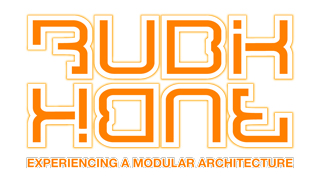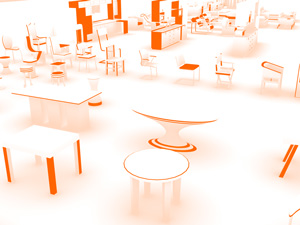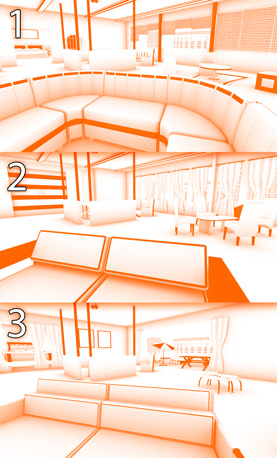 |
|
RUBIKHOME project: Experiencing a modular interactive architectureJÉGO Jean-François, NERTOMB RachelM.A. digital image & virtual reality, candidates. Arts et Technologies de l'Image, Université de Paris 8, France. Abstract:Rubikhome is an interactive visit of a virtual apartment which completely evolves with the physical position of the avatar. Furniture articulates randomly and totally depends on the user’s position. The placing of the furniture comes with a specific sound. In this way, the visitor can literally compose a sound and visual score, which depends on his moving choices. Keywords:modular architecture, interactive visit, perceptions, orientation. |
|
Concept:Originally inspired by an Op’art figure[1]: M. C. Escher, RubikHome is a virtual environment which asks the way users can appreciate an immaterial space through their senses. The idea was to make responding the virtual space while user moves on it. In order to use no psychedelic effects, we preferred handling the architecture and the evolution of the objects which compose this environment. The main concept of how architecture can influence the perceptions is also directly inspired by Haus-Rucker-Co[2], an Austrian art/architecture collective inventor of inflatable structures where two peoples can immerse themselves. This kind of structure can modify perceptions of the close environment, like living in our own little world. The concept of this collective also guides the global style of the application. Technology:Modelling using low polygon techniques with Autodesk 3ds Max, an edging colorization associated with ambient occlusion shadows stylise the objects (a real-time SSAO shader could be integrated in a further development). The real-time 3D engine used is 3DVIA Virtools.
Figure 1: collection of objects used in the virtual space and stylized rendering. Experiment:While some objects keep the same positions, walls can also rotate: the visitor knows the space and can remember elements which compose it, but several one’s are replaced. In concrete terms, an object takes the place of a previous one: we visit a place known at the same time and in constant mutations (fig. 2). The All Seeing Eye[4] provides a similar disturbing experience, while the rotating panorama of a living room, each time a rotation is completed, some objects of the room have disappeared and this until the entire room became empty. |
Interpretation:This disconcerting visit immerses the user who uses his sight and hearing senses, while we use the virtual avatar kinaesthesia to interact. Moreover, the spatial memory is called during the navigation. We can feel destabilized without being lost using an allocentred spatial representation of the environment[6]. In concrete terms, without real references with his physical body, the user has to use a mental simulation of the displacements based on the relation between the objects (and their sounds). It forces to remember the places, and here are the objects without referring our virtual body. Geometry and virtual space are here manipulated by the memory using perspective notions and the field of view, in an immaterial space. This space is however delimited by the volumes (volumetric shadows on the white objects and their border colorization).
Figure 2: three different visions of the same place where objects alternate and the global architecture rotates. Further applications:Rubikhome could be associated with other domains like architecture: singular kind of interactive design pattern, interactive visit, or quick prototyping in real-time. Or in a different field, for example, medical applications: self positioning and memorizing environment (Alzheimer's disease) could permit practising and training for rehabilitation in neuropsychology. Finally, in the marketing field: for furniture choice and space positioning in an interactive catalogue, web applications or product demonstrations. References:[1] Maurits Cornelis ESCHER, Relativity, Lithography,
1953 |
Contact:J-F JÉGO: contact▀jfcad.com |
 |
Publications :Arts et Technologies de l'image n°4 - January 2009
|
- |

